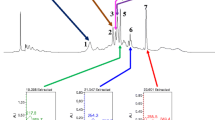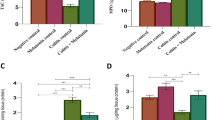Abstract
The intestinal Ca2+ absorption is inhibited by menadione (MEN) through oxidative stress and apoptosis. The aim of this study was to elucidate whether the antioxidant and antiapoptotic properties of melatonin (MEL) could protect the gut against the oxidant MEN. For this purpose, 4-week-old chicks were divided into four groups: (1) controls, (2) treated i.p. with MEN (2.5 μmol/kg of b.w.), (3) treated i.p. with MEL (10 mg/kg of b.w.), and (4) treated with 10 mg MEL/kg of b.w after 2.5 μmol MEN/kg of b.w. Oxidative stress was assessed by determination of glutathione (GSH) and protein carbonyl contents as well as antioxidant enzyme activities. Apoptosis was assayed by the TUNEL technique, protein expression, and activity of caspase 3. The data show that MEL restores the intestinal Ca2+ absorption altered by MEN. In addition, MEL reversed the effects caused by MEN such as decrease in GSH levels, increase in the carbonyl content, alteration in mitochondrial membrane permeability, and enhancement of superoxide dismutase and catalase activities. Apoptosis triggered by MEN in the intestinal cells was arrested by MEL, as indicated by normalization of the mitochondrial membrane permeability, caspase 3 activity, and DNA fragmentation. In conclusion, MEL reverses the inhibition of intestinal Ca 2+ absorption produced by MEN counteracting oxidative stress and apoptosis. These findings suggest that MEL could be a potential drug of choice for the reversal of impaired intestinal Ca 2+ absorption in certain gut disorders that occur with oxidative stress and apoptosis.






Similar content being viewed by others
References
Reiter RJ, Rosales-Corral S, Coto-Montes A et al (2011) The photoperiod, circadian regulation and chronodisruption: the requisite interplay between the suprachiasmatic nuclei and the pineal and gut melatonin. J Physiol Pharmacol 62:269–274
Tosini G (2000) Melatonin circadian rhythm in the retina of mammals. Chronobiol Int 17:599–612
Garbarino-Pico E, Carpentieri AR, Contin MA et al (2004) Retinal ganglion cells are autonomous circadian oscillators synthesizing N-acetylserotonin during the day. J Biol Chem 279:51172–51181
Bubenik GA (2008) Thirty four years since the discovery of gastrointestinal melatonin. J Physiol Pharmacol 59:33–51
Huether G, Poeggeler B, Reimer A, George A (1992) Effect of tryptophan administration on circulating melatonin levels in chicks and rats: evidence for stimulation of melatonin synthesis and release in the gastrointestinal tract. Life Sci 51:945–953
Bubenik GA (2002) Gastrointestinal melatonin: localization, function, and clinical relevance. Dig Dis Sci 47:2336–2348
Bubenik GA, Hacker RR, Brown GM, Bartos L (1999) Melatonin concentrations in the luminal fluid, mucosa, and muscularis of the bovine and porcine gastrointestinal tract. J Pineal Res 26:56–63
Ates B, Yilmaz I, Geckil H et al (2004) Protective role of melatonin given either before ischemia or prior to reperfusion on intestinal ischemia-reperfusion damage. J Pineal Res 37:149–152
Carpentieri A, Diaz de Barboza G, Areco V et al (2012) New perspectives in melatonin uses. Pharmacol Res 65:437–444
Motilva V, Garcia-Mauriño S, Talero E, Illanes M (2011) New paradigms in chronic intestinal inflammation and colon cancer: role of melatonin. J Pineal Res 51:44–60
Perez A, Picotto G, Carpentieri A et al (2008) Minireview on regulation of intestinal calcium absorption. Emphasis on molecular mechanisms of transcellular pathway. Digestion 77:22–34
Graciani FS, Ximenes VF (2012) 2-Bromo-1,4-naphthoquinone: a potentially improved substitute of menadione in Apatone™ therapy. Braz J Med Biol Res 45:701–710
Hattori M, Morita N, Tsujino Y et al (2001) Vitamins D and K in the treatment of osteoporosis secondary to graft-versus-host disease following bone-marrow transplantation. J Int Med Res 29:381–384
Marchionatti AM, Diaz de Barboza GE, Centeno VA et al (2003) Effects of a single dose of menadione on the intestinal calcium absorption and associated variables. J Nutr Biochem 14:466–472
Marchionatti AM, Perez AV, Diaz de Barboza GE et al (2008) Mitochondrial dysfunction is responsible for the intestinal calcium absorption inhibition induced by menadione. Biochim Biophys Acta 1780:101–107
Pascua P, Camello-Almaraz C, Camello PJ et al (2011) Melatonin, and to a lesser extent growth hormone, restores colonic smooth muscle physiology in old rats. J Pineal Res 51:405–415
Almenier HA, Al Menshawy HH, Maher MM, Al Gamal S (2012) Oxidative stress and inflammatory bowel disease. Front Biosci 4:1335–1344
Ferretti G, Bacchetti T, Masciangelo S, Saturni L (2012) Celiac disease, inflammation and oxidative damage: a nutrigenetic approach. Nutrients 4:243–257
Circu ML, Aw TY (2011) Redox biology of the intestine. Free Radic Res 45:1245–1266
Marchionatti AM, Pacciaroni A, Tolosa de Talamoni NG (2013) Effects of quercetin and menadione on intestinal calcium absorption and the underlying mechanisms. Comp Biochem Physiol A: Mol Integr Physiol 164:215–220
Centeno VA, Díaz de Barboza GE, Marchionatti AM et al (2004) Dietary calcium deficiency increases Ca2+ uptake and Ca2+ extrusion mechanisms in chick enterocytes. Comp Biochem Physiol A: Mol Integr Physiol 139:133–141
Tolosa de Talamoni N, Pereira R, de Bronia DH et al (1985) Phospholipids and sialic acid changes produced by vitamin D3 on intestinal mitochondria. Metabolism 34:1007–1011
Tolosa de Talamoni N, Marchionatti A, Baudino V, Alisio A (1996) Glutathione plays a role in the chick intestinal calcium absorption. Comp Biochem Physiol 115A:127–132
Beauchamp CO, Fridovich I (1973) Isozymes of superoxide dismutase from wheat germ. Biochim Biophys Acta 317:50–64
Aebi H (1974) Catalase. In: Bermeyer HU (ed) Methods of enzymatic analysis. Academic Press, New York, pp 673–684
Cheng WH, Valentine BA, Lei XG (1999) High levels of dietary vitamin E do not replace cellular glutathione peroxidase in protecting mice from acute oxidative stress. J Nutr 129:1951–1957
Anderson ME (1985) Determination of glutathione and glutathione disulfide in biological samples. Methods Enzymol 113:548–555
Levine RL, Garland D, Oliver CN et al (1990) Determination of carbonyl content in oxidatively modified proteins. Methods Enzymol 186:464–478
Laemmly UK (1970) Cleavage of structural proteins during the assembly of the head of bacteriophage T4. Nature 227:680–685
Towbin H, Staehelin T, Gordon J (1979) Electrophoretic transfer of proteins from polyacrylamide gels to nitrocellulose sheets: procedure and some applications. Proc Natl Acad Sci 76:4350–4354
Garcia-Calvo M, Peterson EP, Leiting B et al (1998) Inhibition of human caspases by peptide-based and macromolecular inhibitors. J Biol Chem 273:32608–32613
Pastorino JG, Snyder JW, Serroni A et al (1993) Cyclosporin and carnitine prevent the anoxic death of cultured hepatocytes by inhibiting the mitochondrial permeability transition. J Biol Chem 268:13791–13798
Ashkenazi A, Herbst RS (2008) To kill a tumor cell: the potential of proapoptotic receptor agonists. J Clin Invest 118:1979–1990
Aherne SA, O’Brien NM (2000) Mechanism of protection by the flavonoids, quercetin and rutin, against tert-butylhydroperoxide- and menadione-induced DNA single strand breaks in Caco-2 cells. Free Radic Biol Med 29:507–514
Maity P, Bindu S, Dey S et al (2009) Melatonin reduces indomethacin-induced gastric mucosal cell apoptosis by preventing mitochondrial oxidative stress and the activation of mitochondrial pathway of apoptosis. J Pineal Res 46:314–323
Tahan G, Gramignoli R, Marongiu F et al (2011) Melatonin expresses powerful anti-inflammatory and antioxidant activities resulting in complete improvement of acetic-acid-induced colitis in rats. Dig Dis Sci 56:715–720
Swiderska-Kołacz G, Klusek J, Kołataj A (2006) The effect of melatonin on glutathione and glutathione transferase and glutathione peroxidase activities in the mouse liver and kidney in vivo. Neuro Endocrinol Lett 27:365–368
Bhatti JS, Sidhu IP, Bhatti GK (2011) Ameliorative action of melatonin on oxidative damage induced by atrazine toxicity in rat erythrocytes. Mol Cell Biochem 353:139–149
Lee KM, Lee IC, Kim SH et al (2012) Melatonin attenuates doxorubicin-induced testicular toxicity in rats. Andrologia 44:796–803
Rodriguez C, Mayo JC, Sainz RM et al (2004) Regulation of antioxidant enzymes: a significant role for melatonin. J Pineal Res 36:1–9
Tomas-Zapico C, Coto-Montes A (2005) A proposed mechanism to explain the stimulatory effect of melatonin on antioxidative enzymes. J Pineal Res 39:99–104
Jung KH, Hong SW, Zheng HM et al (2010) Melatonin ameliorates cerulein-induced pancreatitis by the modulation of nuclear erythroid 2-related factor 2 and nuclear factor-kappaB in rats. J Pineal Res 48:239–250
Marchionatti AM, de Talamoni NT (2010) Effects of menadione on intestinal calcium absorption and antioxidant enzymes. In: Boveris A, Puntarulo S (eds) XII Biennial Meeting of the Society for Free Radical Research International. Medimond SRL, Bologna, pp 349–352
Pablos MI, Chuang J, Reiter RJ et al (1995) Time course of the melatonin-induced increase in glutathione peroxidase activity in chick tissues. Biol Signals 4:325–330
Pablos MI, Agapito MT, Gutierrez R et al (1995) Melatonin stimulates the activity of the detoxifying enzyme glutathione peroxidase in several tissues of chicks. J Pineal Res 19:111–115
Gerasimenko JV, Gerasimenko OV, Palejwala A et al (2002) Menadione-induced apoptosis: roles of cytosolic Ca2+ elevations and the mitochondrial permeability transition pore. J Cell Sci 115:485–497
Wang H, Xu DX, Lv JW et al (2007) Melatonin attenuates lipopolysaccharide (LPS)-induced apoptotic liver damage in D-galactosamine-sensitized mice. Toxicology 237:49–57
Muñoz-Casares FC, Padillo FJ, Briceño J et al (2006) Melatonin reduces apoptosis and necrosis induced by ischemia/reperfusion injury of the pancreas. J Pineal Res 40:195–203
Mohseni M, Mihandoost E, Shirazi A et al (2012) Melatonin may play a role in modulation of bax and bcl-2 expression levels to protect rat peripheral blood lymphocytes from gamma irradiation-induced apoptosis. Mutat Res 738–739:19–27
Federico A, Cardaioli E, Da Pozzo P et al (2012) Mitochondria, oxidative stress and neurodegeneration. J Neurol Sci 322:254–262
Srinivasan V, Spence DW, Pandi-Perumal SR et al (2011) Melatonin in mitochondrial dysfunction and related disorders. Int J Alzheimers Dis 2011:326320
Dragicevic N, Delic V, Cao C et al (2012) Caffeine increases mitochondrial function and blocks melatonin signaling to mitochondria in Alzheimer’s mice and cells. Neuropharmacology 63:1368–1379
Zavodnik IB, Dremza IK, Cheshchevik VT et al (2013) Oxidative damage of rat liver mitochondria during exposure to t-butyl hydroperoxide. Role of Ca2+ ions in oxidative processes. Life Sci 92:1110–1117
Acknowledgments
This work was supported by Grants from FONCYT (PICT 2005- 32464), CONICET (PIP 2010-12), and SECYT (UNC), Argentina. Prof. Dr. Nori Tolosa de Talamoni and Prof. Dr. Agata Carpentieri are Members of Investigator Career from the Consejo Nacional de Investigaciones Científicas y Tecnológicas (CONICET). Vanessa Areco is recipient of a Fellowship from CONICET. All authors participated in the conception, design, and performance of the study as well as interpretation of data and drafting the manuscript. None of the authors had a personal conflict of interest.
Author information
Authors and Affiliations
Corresponding author
Rights and permissions
About this article
Cite this article
Carpentieri, A., Marchionatti, A., Areco, V. et al. Antioxidant and antiapoptotic properties of melatonin restore intestinal calcium absorption altered by menadione. Mol Cell Biochem 387, 197–205 (2014). https://doi.org/10.1007/s11010-013-1885-2
Received:
Accepted:
Published:
Issue Date:
DOI: https://doi.org/10.1007/s11010-013-1885-2




